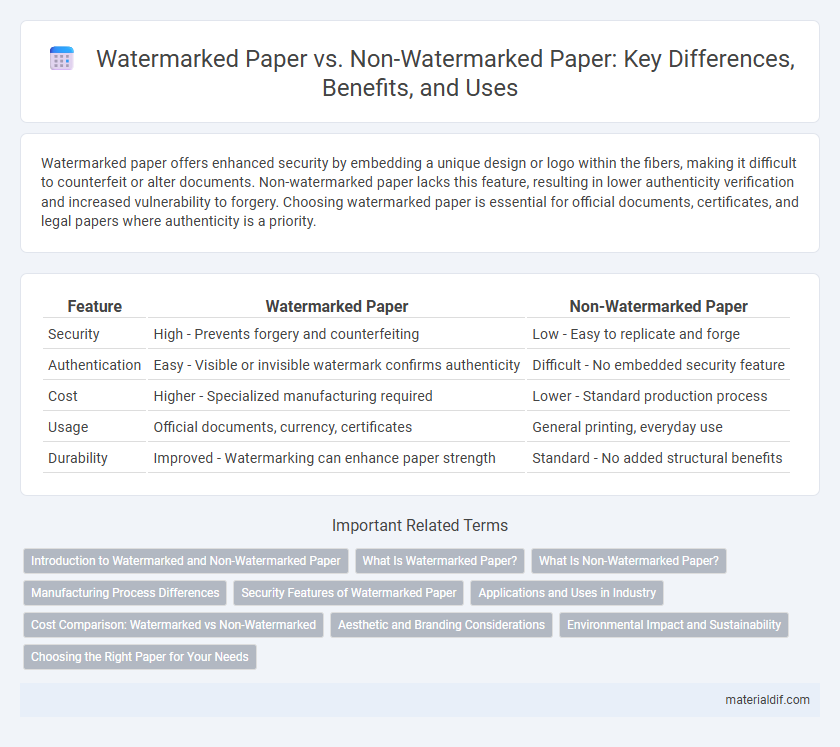Watermarked paper offers enhanced security by embedding a unique design or logo within the fibers, making it difficult to counterfeit or alter documents. Non-watermarked paper lacks this feature, resulting in lower authenticity verification and increased vulnerability to forgery. Choosing watermarked paper is essential for official documents, certificates, and legal papers where authenticity is a priority.
Table of Comparison
| Feature | Watermarked Paper | Non-Watermarked Paper |
|---|---|---|
| Security | High - Prevents forgery and counterfeiting | Low - Easy to replicate and forge |
| Authentication | Easy - Visible or invisible watermark confirms authenticity | Difficult - No embedded security feature |
| Cost | Higher - Specialized manufacturing required | Lower - Standard production process |
| Usage | Official documents, currency, certificates | General printing, everyday use |
| Durability | Improved - Watermarking can enhance paper strength | Standard - No added structural benefits |
Introduction to Watermarked and Non-Watermarked Paper
Watermarked paper features a distinctive translucent design embedded during manufacturing, providing authenticity and security against forgery. Non-watermarked paper lacks these embedded marks, making it more suitable for everyday printing and general use. The presence of watermarks enhances the paper's value in official documents, certificates, and currency.
What Is Watermarked Paper?
Watermarked paper features a translucent design or pattern embedded during the manufacturing process, enhancing security and authenticity by making forgery difficult. This watermark is created by varying the paper thickness in specific areas, visible when held against light, primarily used for official documents and currency. In contrast, non-watermarked paper lacks these embedded features, making it less secure and more vulnerable to counterfeiting.
What Is Non-Watermarked Paper?
Non-watermarked paper is a type of paper that lacks the translucent design or logo embedded during the manufacturing process, resulting in a uniform texture and appearance. This paper is commonly used for everyday printing, copying, and general writing purposes where security or authenticity verification is not a primary concern. Its affordability and wide availability make it a preferred choice for standard documents, brochures, and flyers without the need for built-in anti-counterfeit features.
Manufacturing Process Differences
Watermarked paper is created by manipulating the paper pulp during the manufacturing process, where a metal wire pattern or dandy roll impression is applied while the sheet is still wet, causing variations in thickness that form the watermark. Non-watermarked paper undergoes a uniform production process without any alterations to the pulp or surface, resulting in a consistent texture and appearance. The inclusion of watermarking requires specialized equipment and increased precision, making its manufacturing process more complex and costly compared to non-watermarked paper.
Security Features of Watermarked Paper
Watermarked paper incorporates embedded designs created during the paper manufacturing process, offering enhanced security against forgery and counterfeit. These unique, often intricate patterns are visible when held up to light, making them difficult to replicate with conventional printing methods. The watermark acts as a reliable authentication feature used in currency, legal documents, and certificates to verify originality and prevent unauthorized duplication.
Applications and Uses in Industry
Watermarked paper is widely used in industries requiring high security and authenticity, such as banking, legal documentation, and certificate production, due to its embedded security features that deter counterfeiting. Non-watermarked paper is preferred for everyday printing, packaging, and mass production tasks where cost-efficiency is prioritized over security. The choice between watermarked and non-watermarked paper depends on the need for verification, document integrity, and the level of protection against fraud within various industrial applications.
Cost Comparison: Watermarked vs Non-Watermarked
Watermarked paper generally incurs higher production costs due to the specialized manufacturing process required to embed the watermark, resulting in a price premium compared to non-watermarked paper. Non-watermarked paper is typically less expensive and more widely available, making it a cost-effective choice for everyday printing and office use. However, the added expense of watermarked paper is often justified by its enhanced security features and professional appearance in official documents.
Aesthetic and Branding Considerations
Watermarked paper enhances branding by adding a subtle, elegant design that conveys authenticity and quality, boosting brand perception without overwhelming the printed content. Non-watermarked paper offers a clean, minimalist aesthetic that prioritizes clarity and versatility, making it suitable for general use and diverse branding needs. The choice between watermarked and non-watermarked paper depends on the desired brand image, with watermarks providing a bespoke touch that reinforces exclusivity and premium positioning.
Environmental Impact and Sustainability
Watermarked paper often requires specialized manufacturing processes that can increase energy consumption and chemical use compared to non-watermarked paper. Non-watermarked paper production tends to have a simpler, more resource-efficient process, potentially reducing environmental impact and enhancing sustainability. Choosing non-watermarked paper can support eco-friendly practices by minimizing waste and lowering the carbon footprint associated with paper production.
Choosing the Right Paper for Your Needs
Watermarked paper offers increased security and authenticity verification, making it ideal for official documents, certificates, and legal paperwork where counterfeiting prevention is paramount. Non-watermarked paper is more versatile and cost-effective for everyday printing, drafting, and general office use where such security features are unnecessary. Selecting the right paper depends on the specific application, balancing budget considerations with the importance of document integrity and professional presentation.
Watermarked Paper vs Non-Watermarked Paper Infographic

 materialdif.com
materialdif.com